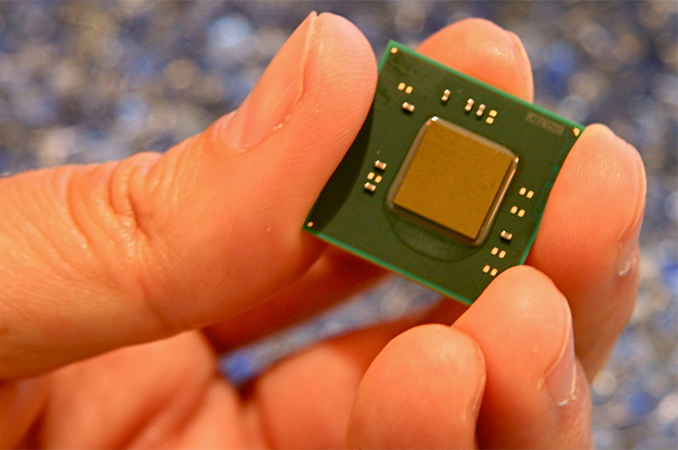Spreadtrum SC9861G-IA: An Intel Atom Octocore Smartphone SoC on 14nm with LTE
by Anton Shilov on March 15, 2017 3:00 PM EST- Posted in
- SoCs
- Intel
- Atom
- Smartphones
- Trade Shows
- Airmont
- 14nm
- MWC_2017
- Spreadtrum

Last year Intel decided to cease development of its smartphone SoCs and focus instead on microprocessors for other devices, as well as LTE, 5G modems, as well as various IoT solutions. While we weren't expecting a new x86 SoC in the space, Intel did not specify that would be the case: the agreements with third-party SoC developers such as Spreadtrum and Rockchip were still in place. Despite this, we were surprised to hear that At MWC 2017, Intel’s partner Spreadtrum introduced a brand new application processor for high-end handsets, featuring Intel’s 2015 Airmont cores (as seen in Cherry Trail) and made using Intel’s 14 nm process technology.
The Spreadtrum SC9861G-IA SoC features eight Intel’s Airmont cores with running at up to 2 GHz, with Imagination Technology's PowerVR GT7200 GPU. Also integrated is Spreadtrum's own 5-mode LTE Cat 7 modem (up to 300 Mbps download, up to 100 Mbps upload). The SoC also integrates an ISP that supports up to two 13 MP camera sensors, a dedicated sensor hub, and hardware-based decoders/encoders for HEVC and other popular video codecs that support up to 3840×2160 resolution. The display controller can handle resolutions up to 2560×1600.
| Spreadtrum's 8-Core Airmont SoC | |||
| SC9861G-IA | |||
| CPU Cores | 8 × Intel Airmont at up to 2 GHz | ||
| GPU | PowerVR GT7200 | ||
| Imaging Capabilities | Up to 26 MP, up to two 13 MP sensors |
||
| Video | 4Kp30, HEVC | ||
| Display Controller | 2560 × 1440 | ||
| Modem | TD-LTE/FDD LTE/TD-SCDMA/WCDMA/EGG LTE Category 7 (DL: 300Mbps, UL: 100Mbps) |
||
| Process Technology | 14 nm | ||
To date, the Spreadtrum SC9861G-IA is the most powerful (and presumably energy-efficient) x86-based SoCfor smartphones. It has more cores, better graphics, and a faster modem than Intel’s own code-named Moorefield SoCs introduced in 2014, made using its 22 nm fabrication process, or the SoFIA chips (designed by Rockchip) launched in 2015 made using TSMC’s 28 nm technologies. Using Intel’s 14 nm manufacturing technology for this new SoC helps to reduce minimum power requirements and die size (which still remain unknown).
The SC9861G-IA is the first x86-based SoC by Spreadtrum, and the development was enabled by an agreement signed in late 2014 after Intel acquired a $1.5-billion worth stake in Tsinghua Unigroup, the owner of Spreadtrum. The chip will not carry the Intel Atom brand, and thus Intel will not help makers of devices to integrate it or make any other incentives to popularize the platform. It will also not invest in its advertising. What is interesting is that the SC9861G-IA will not be Spreadtrum’s last x86-based SoC, according to the CEO of Intel.
“We look forward to working with Spreadtrum on additional mobile platforms,” said Brian Krzanich.
Neither company elaborated on the future plans, and we do not know whether Spreadtrum will continue to introduce smartphone SoCs featuring Intel’s low-power cores, or if they will launch something for higher-end tablets as well.
Intel and Spreadtrum did not disclose when they expect the first devices based on the SC9861G-IA to show up, but only noted that the platform can address both mainstream and high-end handsets.
Source: Spreadtrum










47 Comments
View All Comments
zodiacfml - Thursday, March 16, 2017 - link
Quite late for a high-end since this will be competing with SD820 to Sd830s. It will be awesome for a mid-range with large batteries, phablet or tablet.serendip - Thursday, March 16, 2017 - link
It would be great for cheap Windows tablets because those haven't seen a new chip since the Z38xx two years ago. I'm a big fan of those because a lot of software still needs x86, especially Windows and Linux stuff. There's still a market for tablets cheaper and smaller than Surfaces with their pricey Core M chips.bhtooefr - Saturday, March 18, 2017 - link
This most likely isn't PC-compatible, just like the Moorefield/Merrifield and SoFIA chips before it.And do you mean Z8xxx? In any case, cheap Windows tablets are likely going to be on ARM chips from here on out. It can hypothetically run on any AArch64 platform with UEFI and ACPI support - even as low end as a Raspberry Pi 3 (although it's below the system requirements for 64-bit Windows due to insufficient RAM), if the UEFI developed for Windows 10 IoT Core for RPi 2 is ported to 64-bit.
hojnikb - Thursday, March 16, 2017 - link
Intel should go in way of ARM and just sell those x86 cores as IPsJon Tseng - Thursday, March 16, 2017 - link
On paper that should be a reasonable performer. IIRC Medfield held its own against high end QCOM SoCs back in the day (albeit without an integrated baseband). And Cherry Trail on my Surface 3 can run Skyrim perfectly well (albeit the Intel graphics obviously plays a part and the TDP will be higher).Suspect the challenge will be more on the software side (viz Geekbench results) - are Android apps set up to take advantage of four cores? Also power drain will always be an issue.
lmcd - Thursday, March 16, 2017 - link
Could also potentially be constrained by NAND controller.Smudgeous - Thursday, March 16, 2017 - link
I'd like to see this crammed into something tiny and passively cooled, like the Compulab fitlet. 8 threads would make a nifty little firewall.